Stucco and the blind man
Chapter One. An overview.
We have a serious problem with the construction industry in this country, more profound than most recognize. Excuse the negativity, but we can't march in a positive direction until we define what that direction is.
I speak from the experience of a plastering contractor, a large part of our work is replacing failing stucco, both old and recently done. A few simple steps could have prevented failure in most cases.
Water infilation is the main source of stucco failure. Stucco is a pourous material, like brick, and absorbs water from rain, humidity in the air, sprinklers, etc. Failure from water infiltration is mainly caused by lack of flashing, or edge metal on roofs, such as drip edges and coping or flashing that was poorly done. Sometimes old steel flashing has rusted through causing water infiltration. We also find damage from stopped up downspouts and roof leaks. Lately, we have found failure from metal lath that was made for interior use used on the exterior.
There are other causes of failure such as poorly done lathing, poorly done framing, mortar too thin, etc. I hope to cover all these things in due time.
I want everybody in the world to read what I have to say. I can't change the world if no one reads this. My target audience is members of the construction industry, including new houses and remodeling. Also stucco contractors, who I have a great deal of empathy for. "I can relate".
You may find some of what I say offensive, and maybe insulting, if the shoe fits. Maybe you think I am a Prima Donna or a know-it-all. You are right. I have been called worse things. Please take what I say with the proverbial grain of salt. I have to say what I have to say. This is important, if not critical to our future.
One of my favorite expressions is, if I see a blind man walking toward the ditch, I am going to say something. If he falls in the ditch, don't guilt trip me. The problem is huge. Instead of the blind man, there is an army of zombies, marching and trudging to the edge of the cliff, to fall in their impending doom. I am trying to grab them by he arm and stop them, but they mindlessly trudge, trudge, trudge. "This is how we have always done it." "We have never had any problems with our jobs." Sound familiar ?
Most of the windows I see on my jobs are poorly designed, poorly made, and poorly installed. Pick at least 2 out of three. As a plasterer, a lot of my work is on old houses. In the old days, most windows were well made, well installed, and didn't leak, at least didn't leak much. Many times, windows were made on the job. We sometimes find the carpenter's name and signature on the window jamb. The baffling question is if we are in the information age, with information at our fingertips, and with a higher literacy rate, why this knowledge isn't handed down. Seems to me most this information should be hereditary, or instinctive.
Apart from knowledge shared globally in milliseconds, we have products that weren't available in the old days. For example, caulking and sealants, peel and stick rubber membranes for pan flashing (you won't find pan flashing on an old house), pre bent aluminum flashing from the building supply, or aluminum period. Yet despite all this modern technology, we have leaking and rotting at an epidemic rate, or a pandemic rate. Windows are now made in a factory, with precision tools and machinery, where in the old days windows were made by hand , sometimes one at a time by hand, and someimes right on the job with no power tools.
So, what is wrong with this picture ? When I say windows, I also mean doors. The problems in the industy extend past the windows and doors. We also have large defects in roofing, masonry, etc. The whole industry took a giant step backwards with the invention of EIFS. EIFS is a material already proven to cause severe rot in houses, and has been torn off and replaced with other materials, yet it is still used widely. In fact, EIFS sales increase every year. In 1999, EIFS was torn off nearly every house it was put on in North Carolina. Why do we forget the lessons we learned in the past ? Remember Vietnam ?
The demographic landscape has changed. Immigrants, mostly Hispanics, do most of the construction work. I don't know what we would do without Hispanics. Other industries, meat cutting, chicken killing, canning, landscaping, etc. have been taken over by Hispanics. Farm work and fruit and vegetable picking have been dominated by Hispanics for years. Apple picking has seen a large influx of other immigrants such as Jamaicans in recent years, but Hispanics still dominate. In the words of George Bush, Immigrants do the work Americans will not do. You don't have to agree with George Bush to agree with this statement. Immigration reform was put on the shelf back in 2008, and needs to be revisited again. One sure fire way to get rid of illegal aliens is to make them legal.
I am not trying to stereotype with race or ethnic groups. I am calling the shots as I see them. There are too many opportunities in other industries to interest American citizens in the building trades, or construction work. There is a huge demand in IT. Programming, security, system administration are hot employment opportunities. The medical field has high tech positions available due to breakthroughs in recent times. The idea of hard, heavy, and dirty work out in the hot sun and freezing cold just isn't that appealing. Immigrants, fortunately, have become a willing work force.
The building boom at the turn of the century, the last century, that is (1900) brought over a large migration of Italians. A large fire in Baltimore and a earthquake in San Francisco created a demand for skilled and unskilled workers from Europe. Skilled tradesmen from Italy included plasterers, marble masons, tile setters, bricklayers and others. Evidence of the Italian influence in constuction can be seen in Baltimore. In Baltimore, the stucco work done in the 20's and 30's is incredible. Go by the old cemetaries in Baltimore and you'll see lots of Italian last names. My point here is back then, the immigrants brought building skills with them, and were even used to train Americans. These days, immigrants coming over, for the most part, don't have the construction skills like the Italians. Certainly not all the time, but generally this is true.
So now our immigrant workforce is untrained, who is there to do the training ? The blind lead the blind lead the blind. With more and more low skilled or unskilled trades the blind are everywhere.
EIFS workers are the lowest paid building trade. In fact, in Baltimore, which is heavily unionized, laborers who mix the EIFS mortar and clean up make almost twice as much as an EIFS mechanic. More about EIFS later. Please read on to find what I say about windows.
Chapter Two. Windows and doors
What happened to flashing ?
Most of the windows we see are poorly installed, or poorly made. It's about time window manufacturers stood back and took a sober look at the product they are making.

Picture shows the top of a window made by a big national window manufacturer, whose name starts with the letter "A". The top is slightly angled down toward the wall, deflecting water into the wall. Water goes behind the window, runs down the sides, and rots the framing at the bottom corners of the window. No, caulking doesn't help. Water pentrates the stucco, and when water hits the top of the window, it luns down the sides. This is also true on siding installations. There usually are holes and small leaks in the siding, not to mention normal condensation. Window construction like this is a funnel.
Important addendum-February 5, 2023
Sorry to bad mouth the window manufacturer. The window above is made for wood trim which is whay it is square to the wall. More and more of these windows are put on these days with no trim on top, leading to a water funnel. Bear in mind, rot below the window is caused mostly by water that runs across the top, which is level, and then down the sides of the window jamb. The manufacturer offers flashing for the windows, but it must be requested. In the picture below, the flashing is made custom fit to the window, and even the same color. The flashing is shipped in cardboard mailing tubes. See below the flashing on the house we just finished:
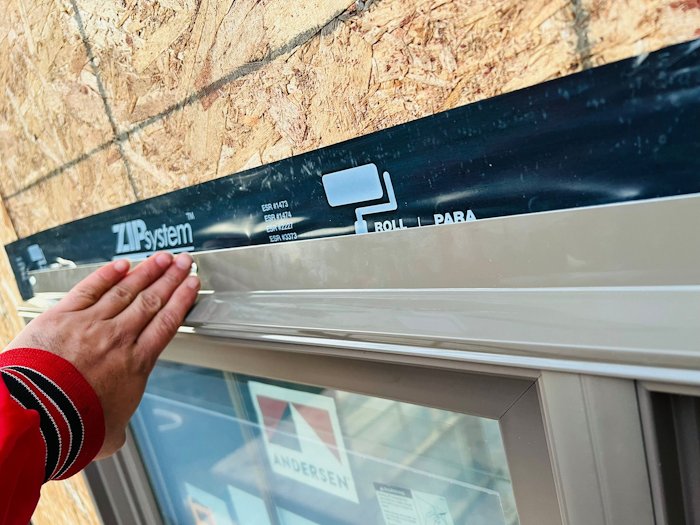
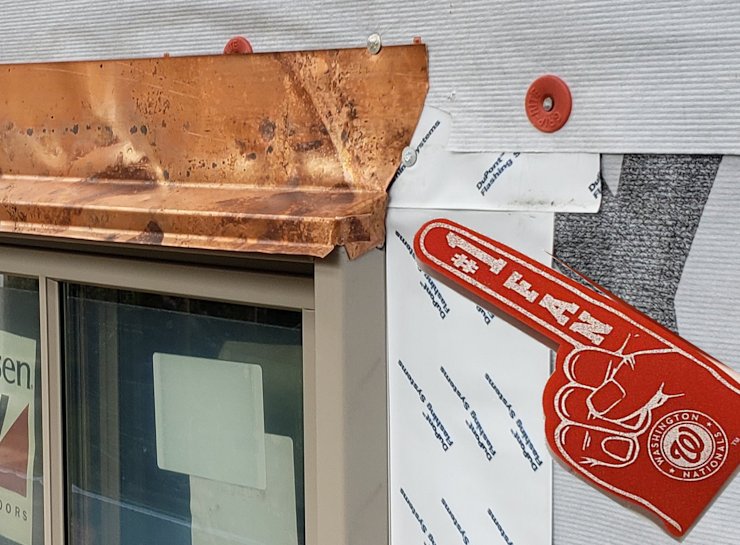
Picture shows how we corrected the water funnel. Copper flashing is put over the window and angled down, that is,away from the house. The nailing flanges are sealed with wide tape. A layer of tarpaper is put on over the housewrap, overlapping the flange on top of the flashing. Water that penetrates the stucco and runs down to the flashing should exit the house instead of enter the house. It is important not to caulk over this flashing. A small crack will develop between the flashing and the stucco because mortar doesn't bond to metal. This crack is the water exit. The tendency of people to caulk this crack with an ugly wide gob of caulk creates another water funnel. More details about this project can be found here.
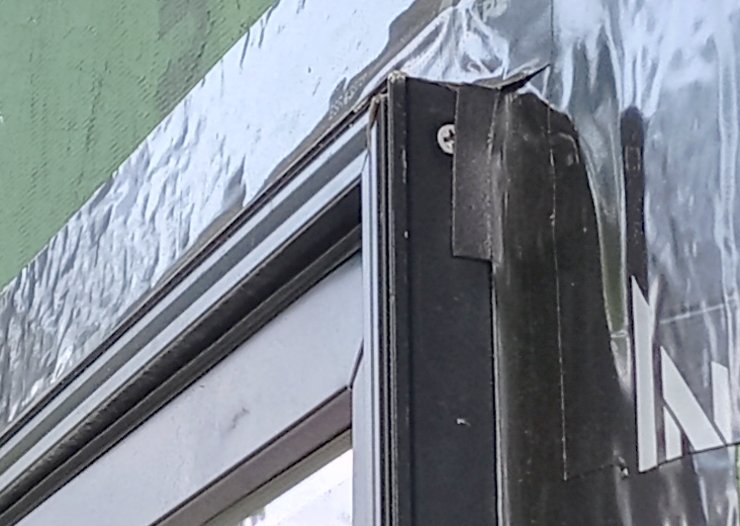
Picture shows a water funnel where the window is angled in toward the building. The window was made by a big manufacturer whose name starts with the letter "p".
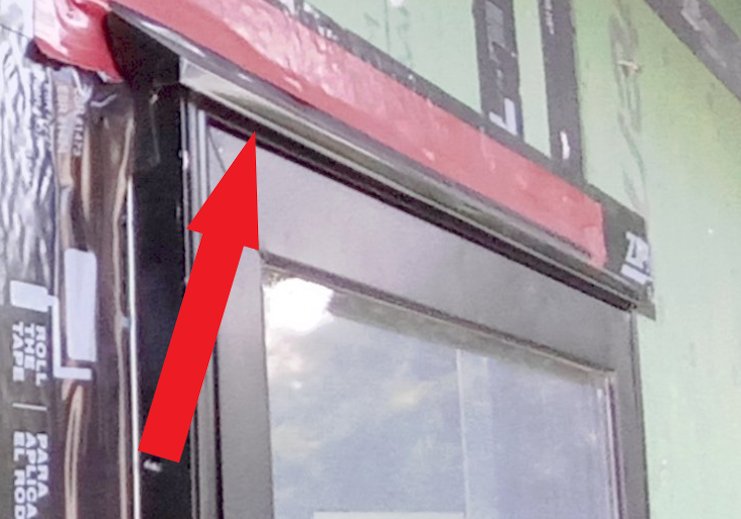
This picture shows the same old stuff, a different day. We used pre-bent window flashing, or window cap, from Home Cheap-o. We spray painted the flashing gloss black to match the windows and put it on.The top flange is sealed with red tape and overlapped with tar paper. We put tar paper over zip wall. The zip wall people claim you don't need an additional vapor barrier, but I put on tarpaper anyway. I sure can't hurt.
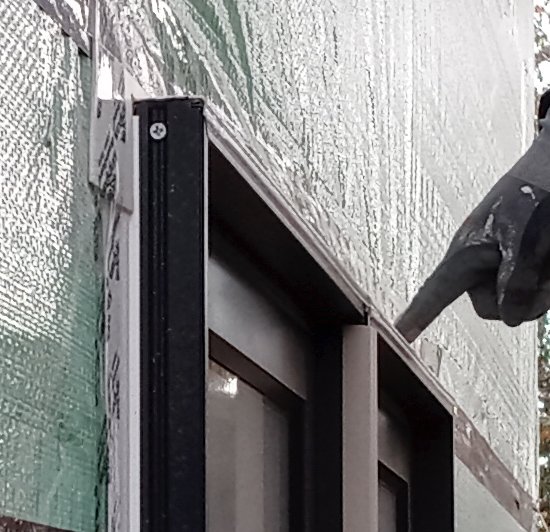
Another new window level or angled in at the top.
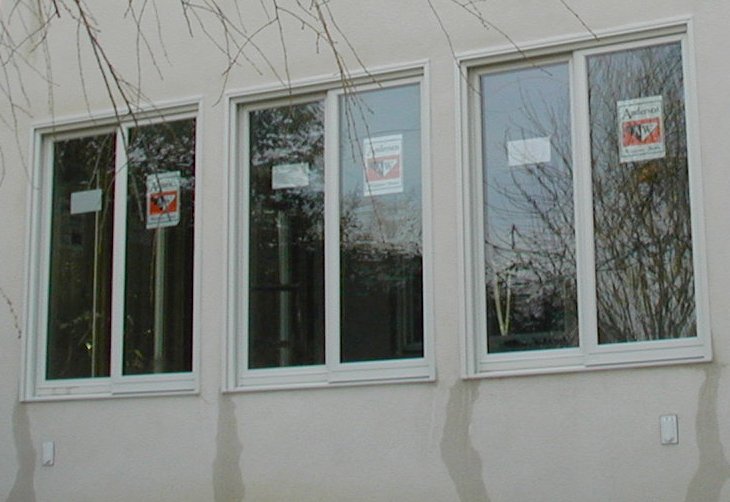
These sills were made to weep on the sides. It will damage my stucco. This is a stucco addition we did in 2003. I stood back to take a picture and this is what I got.
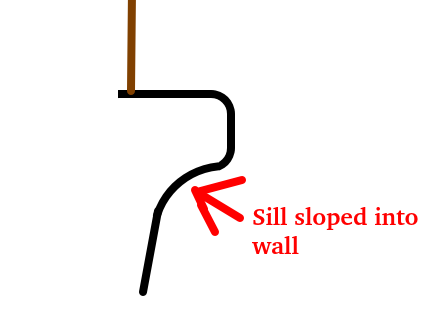
The sills on this house in Stafford, Virginia were shaped to deflect water into the wall. I couldn't find a good picture so I drew the sill.
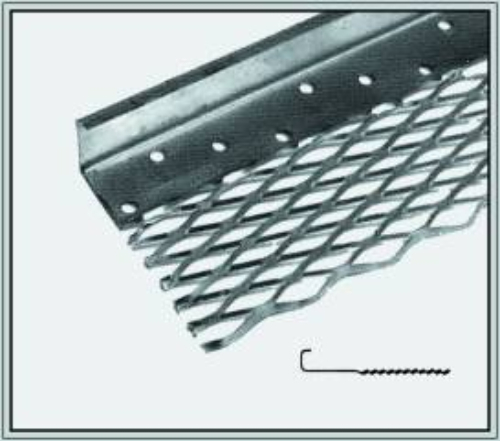
Probably the worst thing people do without realizing the consequences is to leave a gap between the stucco and the window. This is usually done by surrounding the window with casing beads, and filling the gap with caulk. We find severe rot when we tear off installations done like this with wood trim or wood framing. This method is often specified on the plans. This needs to stop. The idea is to create a gap between dissimilar surfaces. Since mortar won't bond to wood, metal or whatever, a small crack (usually) appears between the stucco and wood, or whatever. We did this on commercial work, such as hospitals, schools and government buildings and it looked neat and usually there was no problem. But in commercial work, the dissimilar materials were usuallay concrete, metal door jambs, concrete, or whatever and not wood. Also, the substrate for the stucco , or interior plaster, was metal framing, exterior gypsum sheathing, block or other materials that don't rot like wood. If whoever draws these plans could see what we see, they would stop this practice. Speaking from experience in tearing off failed stucco installations, the casing bead and caulking traps water against the wood causing rot. The casing beads, also known as plaster stop, deteriorate and we find galvanized beads so badly rotted in less than 5 years that you can pull them off with your fingers. The worst we have seen with this method was a house in Alexandria, Virginia where the owner had his neighbor stucco the house 30 years before. The neighbor was a plastering contractor. The beads had rotted so bad, and the wood framing had rotted so bad, that we could pull ot the windows with our bare hands. The wood framing and sheathing bellow the windows had rotted so bad that the house sagged, and was infested with insects. The house had to be jacked up and supported with new lumber. I have seen this condition several times. I have a lot of experience in tearing off failed stucco.
Caulking around windows sometimes does more harm than good. There is a myth circulating that on an EIFS or one coat stucco house, the caulking needs to be scraped off and replaced every so many years, usually five years. The caulking, or lack of caulking causes rot. The reason I know this, is people call me looking for somebody to replace their caulking. I know someone here in northern Virginia who largely makes a living caulking EIFS and one coat stucco.
For example, I got a call recently from a woman who wanted cauking replaced. I get calls for EIFS repair and one coat stucco repair from web searches for a stucco contractor. She said she had a "hard coat" stucco house and had a damaged area under the window. This house is in a neighborhood near me. The houses are one coat stucco and many have foam EIFS details over the windows. She explained she needed the caulking replaced on the sides and bottom of the window because the caulking was bad. The bad caulking is what caused the damage. I know this is absurd, but I wanted to get off the phone so I recommended her to an EIFS contractor who does small caulk jobs. Usually someone tells me that so and so told them the caulking needs to be replaced every 5 years. The next time I get a call like this I'll explain that water runs downhill, and not horizontally through a solid object. The water is coming from above the window and not from the sides. For $ 200 I'll come over and show them what they need to correct their problem.
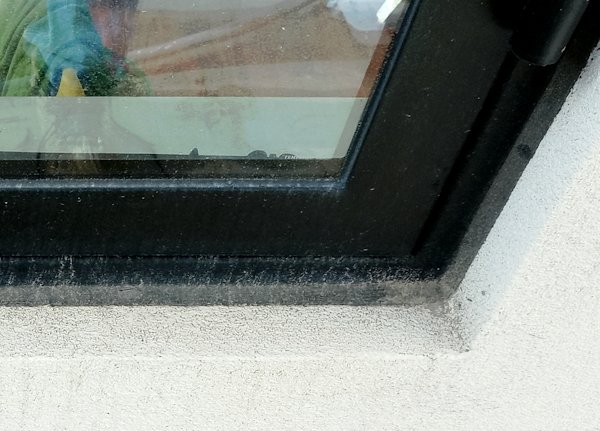
Water funnel is created by returning stucco (in this case, one coat stucco) back to the bottom of the window. Water soaks into the level surface a causes rot. This is a house we are working on in Alexandria, Virginia. We tore off this 9 month old stucco application and re did it.
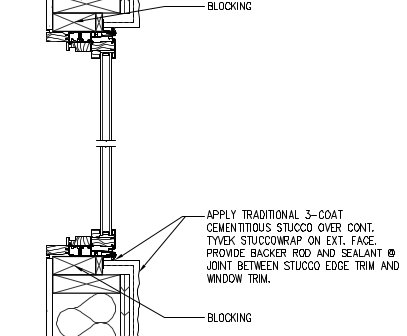
The plans for a house we worked on in Bethesda were really drawn with this plan for failure.
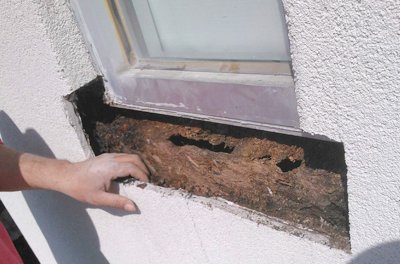
Here's what a window done like this looks like in 4 years. More detais about this disaster here:
Also here: Please check out how we corrected this disaster.
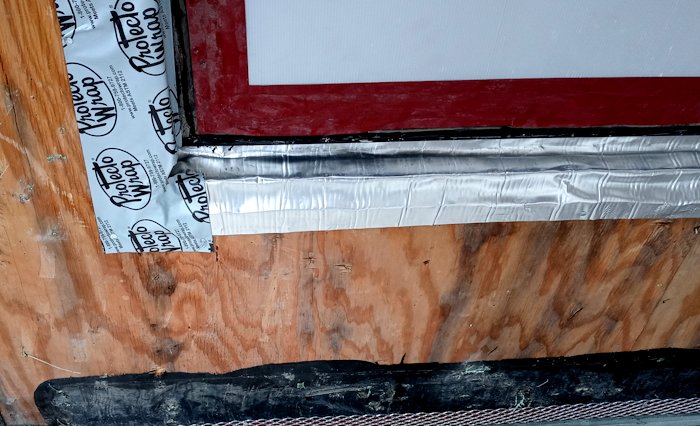
In case you are wondering how we rescued the house in Alexandria, Here's what we did: After we tore of the stucco, we cut off the stud below the window. This allows for the pitch on our stucco window sill. The inside of the window was wrapped with peel and stick flashing. Then we put on our tar paper and lath. Note the black streaking below the window, This would have been severe rot after a few short years.

This picture frame type window trim needs to stop. I think the idea is fast and cheap. I have published what I think about this method on my site. This trend is another path to failure. I see this a lot, and you don't see picture frame trim on old houses. The design of a window sill is supposed to be angled down and away from the building. Sills are disappearing more and more, and this trend must stop or we'll have more rot. I have heard this idea defended as the "clean look", but I see nothing clean looking about rotten framing.
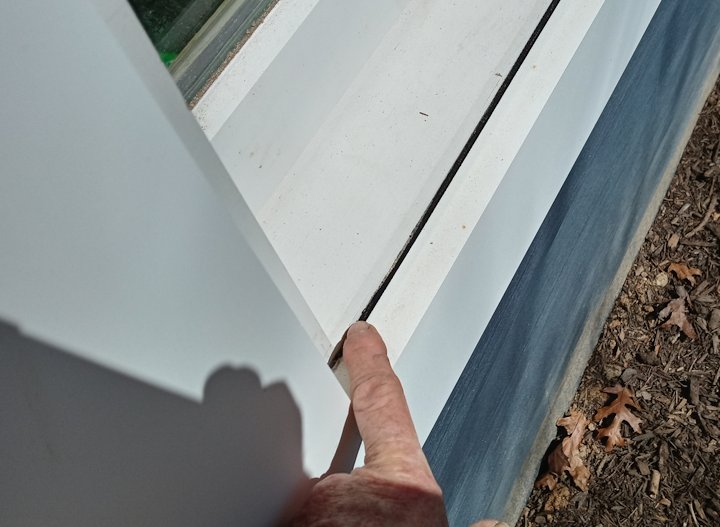
A close up of a picture frame window sill, showing the path to disaster. Even filling the gap with caulking won't avoid the water intrusion. the sill is level allowing water to sit on the wood. At best, this will lead to premature paint peeling and wood rot. At worst, the framing supporting the window and the whole house will rot. Even with caulking, relying on caulking is relying on a thin film of hope. You may have seen what I wrote about window sills here:
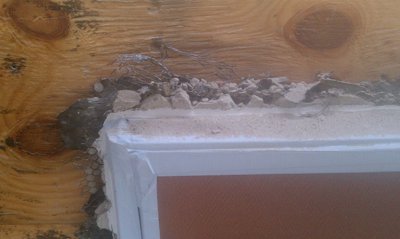
This shows how a lack of flashing above the window causes rot below the window. Remember, water will penetrate stucco whether it has been painted or not. Water runs down the sides of the window trim, behind the window trim, and down between the jamb and the framing. This is the main source of rot below the window on stucco and EIFS tear-offs we do. You may have seen what I wrote about flashing windows here:
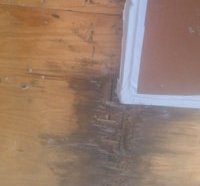 Below the window. I hope to find a better picture later.
Below the window. I hope to find a better picture later.
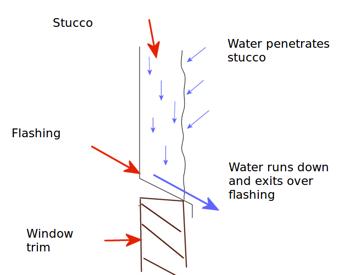
Correct flashing over window: Flasning is angled forward, deflecting water out and away from the building. On stucco applications, a gap will ususally form between the flashing and the stucco. This is a water exit.
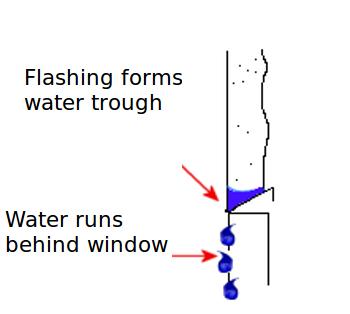
When flashing is put on backwards, that is, angled into the wall, a water trough forms. The window trim is level, so water runs across and down the sides of the window, and usually, into the wall.
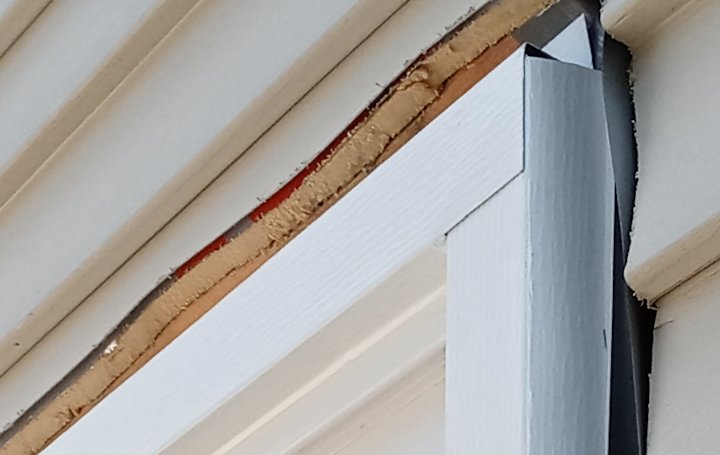
An example of backwards flashing: A water trough forms running water to the sides. In this case, the flashing is cut short, running water into the aluminum trim. Not only does this rot the window inside the aluminum wrap, but water runs down rotting the framing supporting the window, and the house.

This backwards flashing caused severe rot on this new house. I published details about this project here:
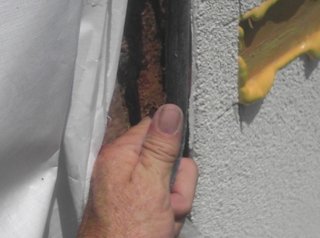
The framing lumber was like wet oatmeal. This was the second time this wall was repaired. The original contractor came out and put on more backwards flashing the second time. I guess they didn't learn their lesson.
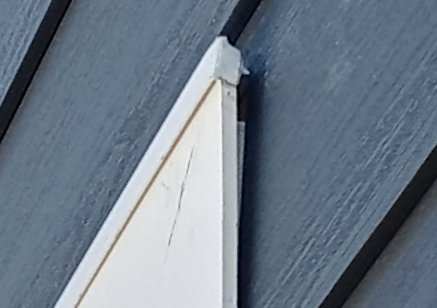
I don't know whose idea this was. Flashing over thin wood trim is angled into the wall, deflecting water into a channel that runs behind the siding. If you want to rot a house quick, this is a good method. One resource we'll never run out of in this world is stupidity.
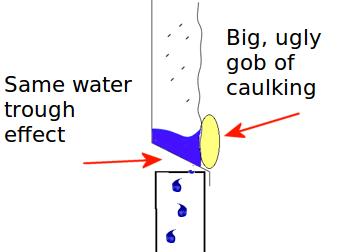
You may have seen this here: A gob of caulking seals the water exit over the flashing. Cement mortar doesn't bond to metal, so a crack will usually appear above the flashing. I think the idea of caulking is to prevent air infiltration or water infiltration, but it is impossible for air or water to enter this crack. It is equally important not to seal the gap over the flashing for siding or other materials.
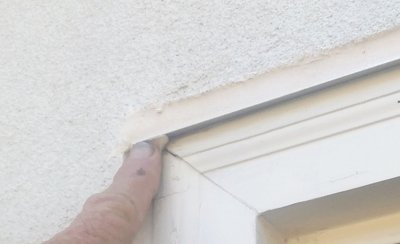
Photographic proof: This one-coat stucco application has EIFS foam details over the door and a big wide gob of caulk on the flashing. It would have been fine to caulk under the flashing if one wanted to stop air infiltration, but logic wasn't followed.
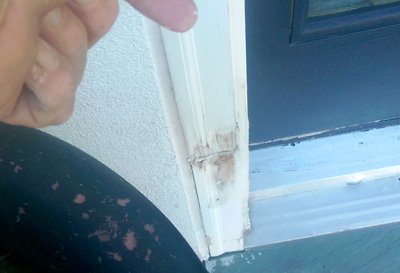
The lower part of this door trim has been patched, as well as most of the doors in this neighborhood. The bottoms of the doors that haven't been patched, have obvious rot. These fairly new houses are all like this.
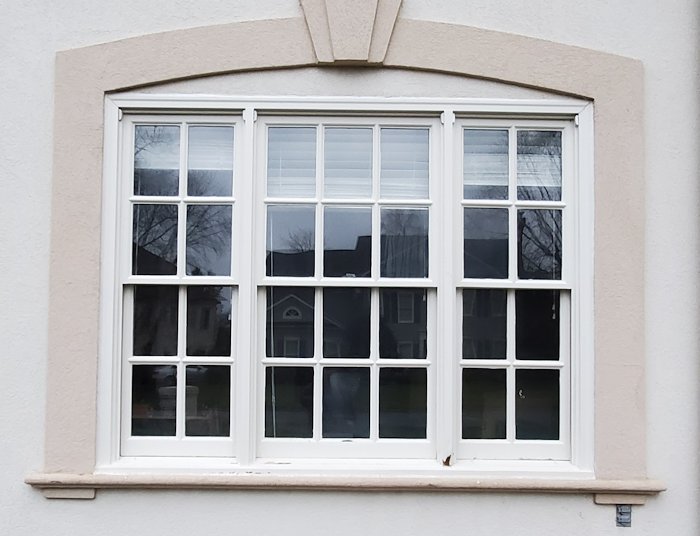
A gob of caulking seals the water exit over the flashing. Cement mortar doesn't bond to metal, so a crack will usually appear above the flashing. I think the idea of caulking is to prevent air infiltration or water infiltration, but it is impossible for air or water to enter this crack. It is equally important not to seal the gap over the flashing for siding or other materials. Water runs down the posts on the window and rots the bottom of the post and the sill.
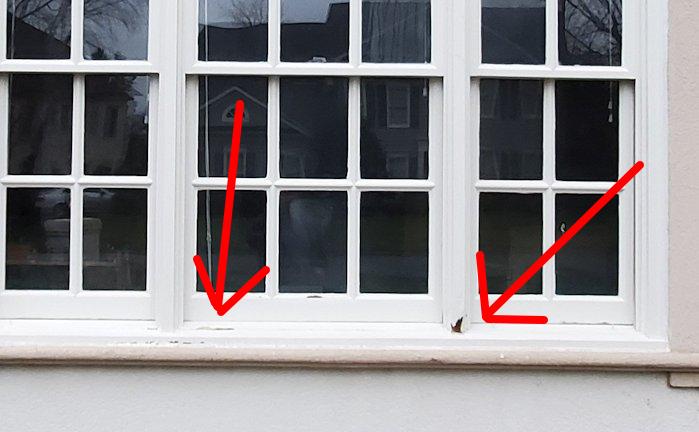
Water runs down the posts on the window and rots the bottom of the post and the sill. The houses in this golf course community are less than 20 years old, yet the windows are rotting. We work on houses over a hundred years old, and the windows are in good shape.
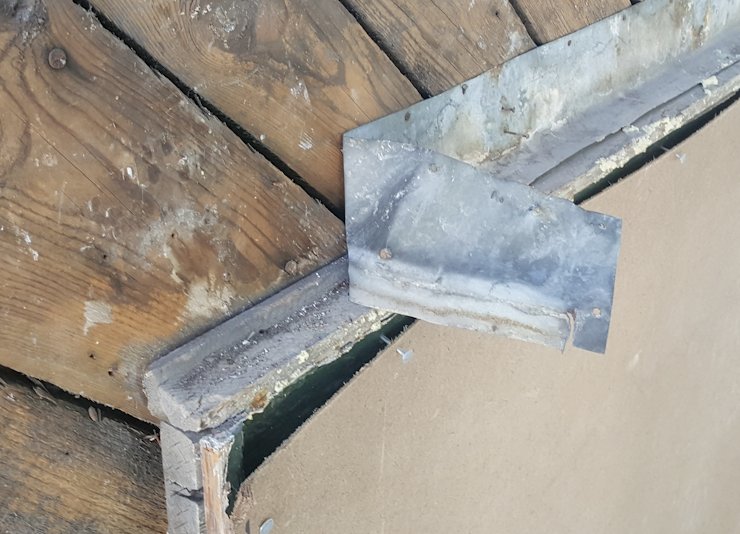
The people who flashed this window over a hundred years ago had the right idea. They put on an angled shaped molding to maintain the angle of the flashing the right way. Too bad they used steel flashing back then, and the flashing was short of covering the edge of the trim. One point I am trying to make of all this is, in the old days, people put on flashing with the right pitch, yet here in modern times the trend is more and more to put on the flashing angled the wrong way, or into the wall. These days, we have internet, and information is dissiminated in milliseconds. We also enjoy the highest literacy rate in history. So what happened in the evolutionary scheme of things to cause this massive failure ?Here's more details here..
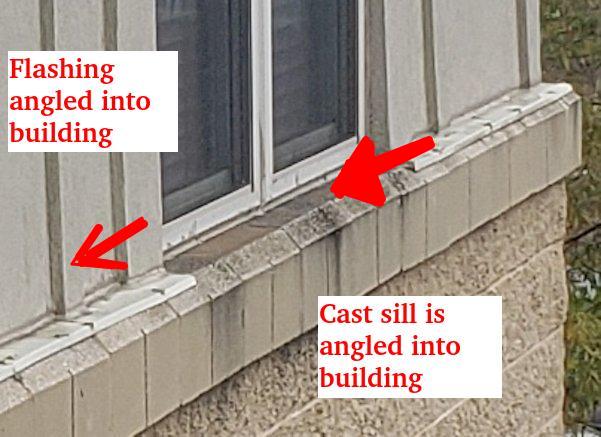
You may have seen this here: This 4th floor apartment leaks like crazy when it rains.
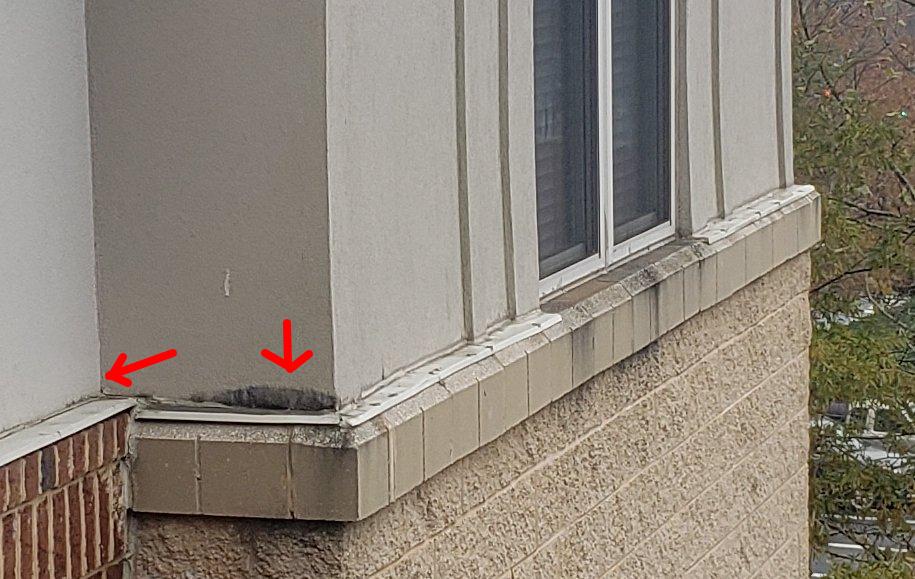
Flashing is angled into the building. Note the mildew growing in the water pool. What good is the caulking ? Water is now trapped behind the EIFS. The joints on this backward flashing create a water funnel, like a bathtub drain, water runs down the lowest point.
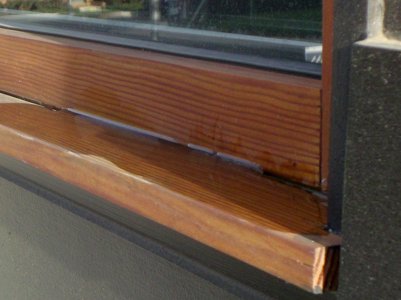
I wrote about backwards sills here: Standing water pools against window on this new construction. Sills were angled backwards on the custom made millwork.
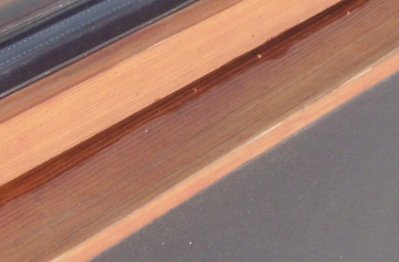
The polyurethene finish on this 9 month old woodwork has faded and dulled from water damage. Sure don't build 'em like they used to.
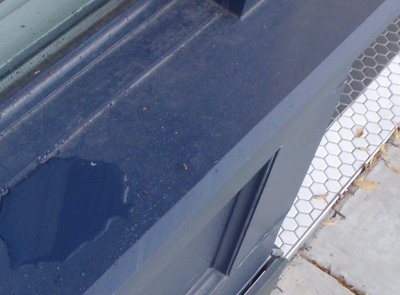
I walked around for a city block and didn't find a sill that wasn't backwards. The ceilings were water funnels and failing but that is a subject for a later chapter. This is a picture from a Madewell store we did the stucco on. I washed the windows and noticed water pooled up on the sill, showing the sill was backwards on this high end millwork.
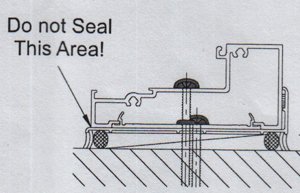
The manufacturers of window mullion and store front type windows provide an elaborate drainage system and weep holes. Any water that seeps through the gasket or forms from condensation is directed out the weep holes. Note the manufacturers instructions saying do not seal this area.
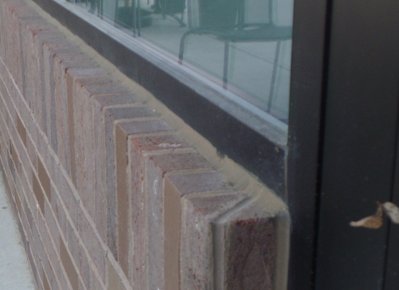
On newer buildings, the weeps are almost always caulked shut. Note the level window sills. On old buildings the sills are almost always pitched down and away from the building.
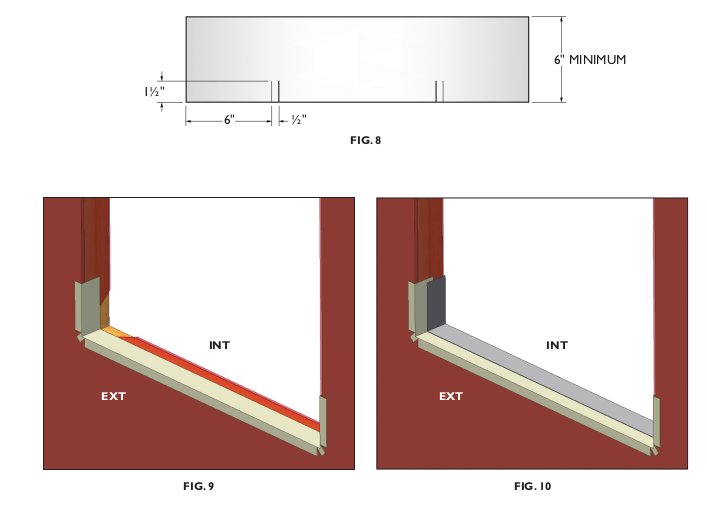
Manufacturer's intructions for window installation show a metal pan flashing on the bottom and sides of the window is required. Of course, the people who installed this brand of windows on this high end remodeling project just stuck the windows on the bare framing. I have never seen metal pan flashing used except on Youtube videos from other states. I have seen protecto-wrap and other peel and stick rubber membrane flashing used, but not very frequently.
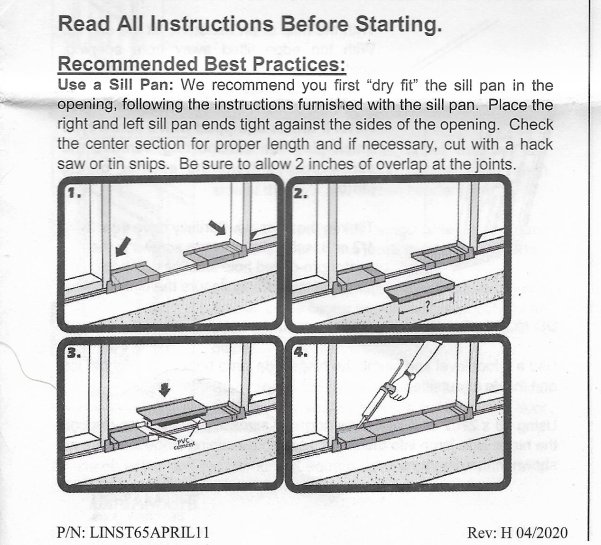
I found these door installation instructions itn a sealed envelope in a trash pile near where this new door was installed. The first instruction, "Read all instructions before starting" wasn't followed. The instructions required using a door sill pan supplied in an optional sill pan kit.
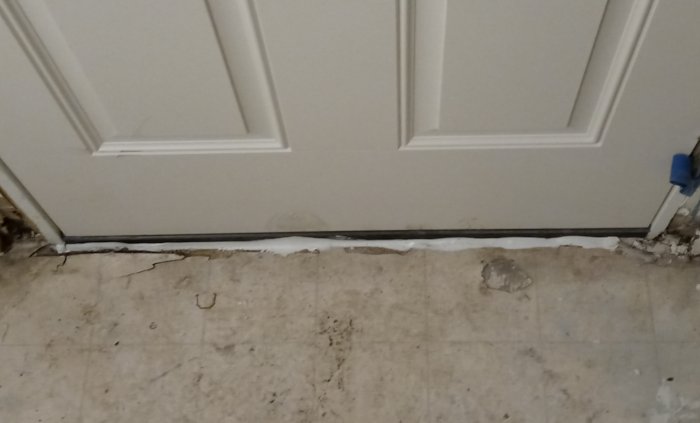
We don't need no stinking sill pan ! I have only seen door sill pans twice, except in Youtube videos, in my 52 years in construction. Once we saw sill pans backwards, so any time it rained, water ran into the house. I think these should be important, particularly on wood framing and wood floor substrates. Check out this caulk job: this was probably done by mentally challenged people anyway, no offense to morons. Fortunately, this is on concrete. Any water trapped under the threshold plate entering from the door casing would rot wood floors.
Nearly all sliding glass doors have weep holes in the threshold plate, all except cheapos. Instructions must be followed in sealing under the doors to not caulk the weeps shut. I have only seen two jobs where the weeps weren't caulked shut. A neighbor of mine had a sliding door installed, and the installer put the door in upside down, that is with the threshold with the weeps at the top.
In the 50's and 60's, when someone had storm windows installed, the installer would drill at least 2 weep holes in the window sill from inside the frame of the storm window, (or screen), leading down toward the outside. This allowed water entering the frame to exit. I know this from working on old houses. Just think, electric drills back then were expensive and cumbersome, and hand drills were frequently used. I find these weep hold caulked and painted shut most of the time. I challenge anybody to show me a storm window put in after 1970 done this way with weeps. Remember, I have a right to be a know-it-all. A lot of our stucco patch work comes from rotted window sills.
Addendum: May, 2023
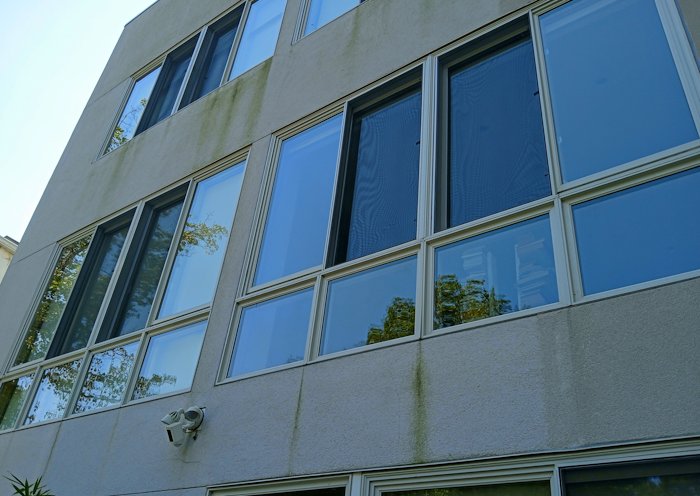
Every time it rains hard water runs in this house in Washington, DC and pools on the living room floor. This is an older house with a recent remodel that included new windows and stucco with a cement basecoat and a synthetic finish.You may have seen this house here on my November 2022 home page. The stucco sticks out past the window so water runs down into the house. Also, the center posts leaks. Water enters the center posts at the top and is funneled into the wall.
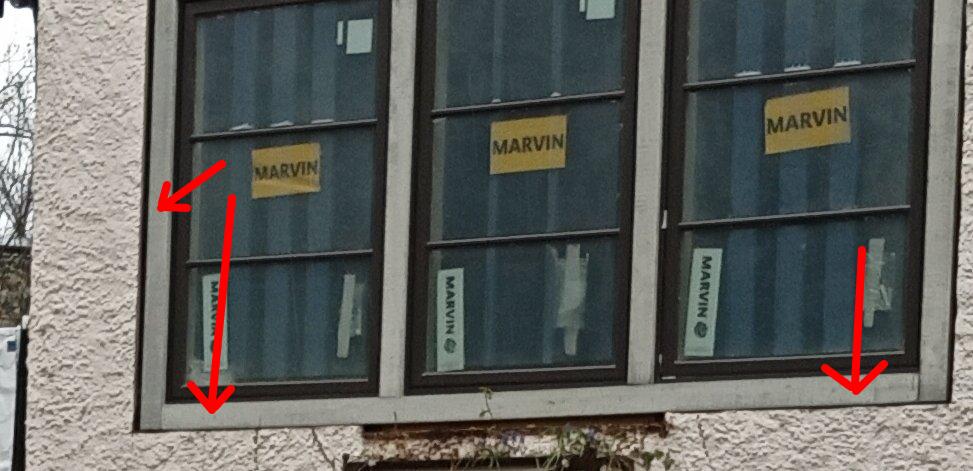
The idiots that put in these windows cut around the stucco, and put in the window recessed into the wall, that is the stucco sticks out past the window. Any time it rains, water runs down the window and into the wall. This is a house remodel in the Foxhall Road area of Washington, DC.
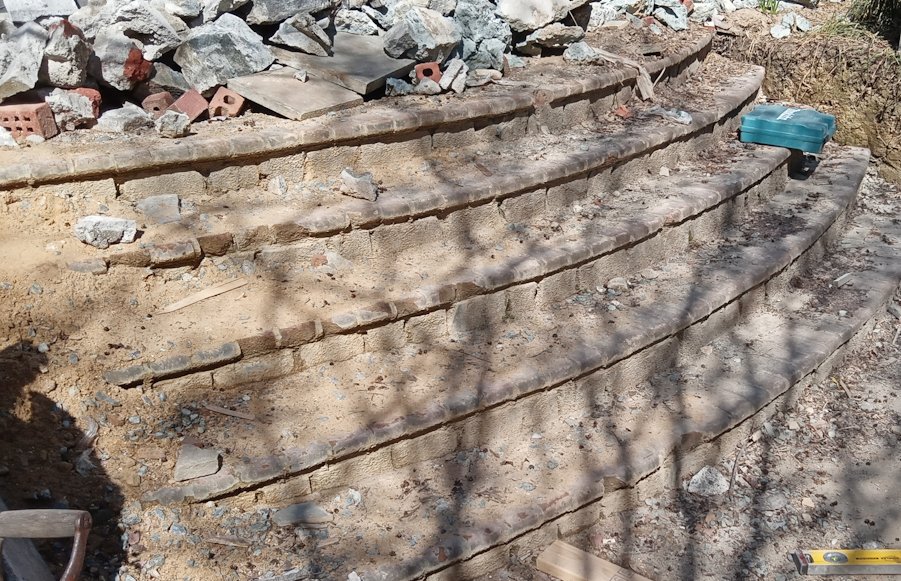
This is the same project, but different idiots. Not related to windows and doors, but this made me so mad to see this, I had to say something. The stone contractor threw their stones, brick and block and heavy concrete chunks on this nice old stairway. The stones bouncing down the stairs broke up the noses and bricks on these radiused steps. These stairs are beyond repair. Repairing the bricks would look terrible. The only way to correct this damage is to tear out the bricks and rebuild the stairway.